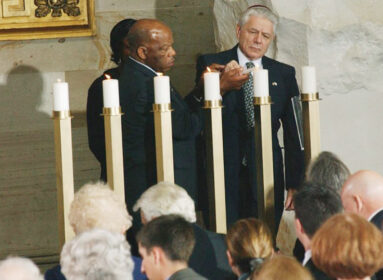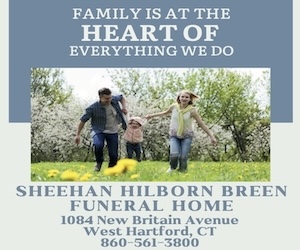 Jewish Connecticut Responds to the Pew Survey of American Jews
Jewish Connecticut Responds to the Pew Survey of American Jews
By Cindy Mindell
Now that the dust has settled a bit on the Pew Research Center’s “A Portrait of Jewish Americans,” it’s time to see how Jewish Connecticut is responding.
Conducted between February and June, this is the most comprehensive national survey of the Jewish population since the 2000-2001 National Jewish Population Survey conducted by United Jewish Communities (now Jewish Federations of North America). More than 70,000 screening interviews were conducted to identify Jewish respondents in all 50 states and the District of Columbia. Longer interviews were completed with 3,475 Jews, including 2,786 Jews by religion and 689 Jews of no religion. While many communities are taking steps to incorporate the findings of the Pew study into their programming, not everyone accepts the findings as gospel, so to speak. In short, the study has its detractors.
While respondents overwhelmingly reported that they are proud to be Jewish and have a strong sense of belonging to the Jewish people, the survey also suggests that Jewish identity is changing in America, where one in five Jews (22 percent) now describe themselves as having no religion.
The survey explored identity, intermarriage, religious beliefs and practices, attitudes toward Israel and the Holocaust, and social and political views. The entire report is available at pewforum.org.
The Ledger asked representatives of Connecticut’s Jewish communities to weigh in on how the findings impact upon their respective constituencies and future plans. Several responded.
The Academic Perspective
Most American Jews seemed happy with their lives and proud of being Jewish in their own way, says Dr. Barry A. Kosmin of Trinity College in Hartford, research professor in public policy and law, and director of the Institute for the Study of Secularism in Society & Culture.
“This presents a challenge for Jewish institutions and leaders who are definitely not happy with the findings and the current state of American Jewry,” he says.
 The high rate of intermarriage – 58 percent – remains a challenge, Kosmin says: “In reality, the rate is higher, since fewer young people do not get married but instead live together. This means that more than two mixed couples are produced for every in-married Jewish couple.” In addition, Jews seem to be secularizing and increasingly rejecting religion – 32 percent of young adults. “So new forms of cultural education and attachment seem to be required in order to capture the new attitude and provide new ways of being Jewish, compatible with 21st-century technology and lifestyles,” he says.
The high rate of intermarriage – 58 percent – remains a challenge, Kosmin says: “In reality, the rate is higher, since fewer young people do not get married but instead live together. This means that more than two mixed couples are produced for every in-married Jewish couple.” In addition, Jews seem to be secularizing and increasingly rejecting religion – 32 percent of young adults. “So new forms of cultural education and attachment seem to be required in order to capture the new attitude and provide new ways of being Jewish, compatible with 21st-century technology and lifestyles,” he says.
As for numbers, Pew reports a larger population of Jews than has been identified by past surveys. “Since all the demographic rates go in the opposite direction, this is questionable, especially a 15 percent growth in the number of ‘Jews by Religion’ category since 2001,” Kosmin says. “Though higher numbers may make some leaders happy, they also mean that all types of Jewish affiliations and connections are lowered – lower rates of children receiving Jewish education, a smaller percentage of Jews belonging to synagogues, and lower rates of Jewish giving.”
The best news from the survey, Kosmin says, is that the Jewish “brand” is strong in American society. “In theory there’s a large constituency still for ‘Jewish products,’” he says. “Nobody today feels the need to hide their Jewishness and many people on the periphery of the Jewish community are happy to identify with Jews and Jewish culture. Tapping into these positive sentiments is both an opportunity and a challenge for Jewish organizations.”
The Hartford Perspective
On Nov. 5, Kosmin was one of five speakers at “Let’s Talk about Pew,” a panel discussion hosted by the Jewish Federation of Greater Hartford at Beth El Temple in West Hartford. The event drew some 250 community members, from 20-somethings to seniors. Kosmin was joined by Federation director Cathy Schwartz, Board chair Bob Yass, University of Hartford professor Avinoam Patt, David R. Miller, chair of the Jewish Community Foundation, and Rabbi Debra Cantor of Congregation B’nai Tikvoh-Sholom in Bloomfield.
“Almost none of the study’s results surprised me,” Cantor said in her remarks. “The study reflects trends which those of us involved in the Jewish community have observed over many years. And those trends seem especially alarming for synagogues. But we must be careful not to react with panic or to catastrophize. Synagogues today need to be responsive and open; we need to practice a more radical form of hachnasat orchim, of welcoming folks into the orbit of the Jewish community.”
Over the past year, Greater Hartford Jewish organizations have been working with the Big Tent Judaism Initiative, funded by a 2012 grant from the Jewish Community Foundation of Greater Hartford. As an initial result of the project, the community, led by the Jewish Federation and the JCC, has invested in several new programs to engage particular demographics – among them, Moishe House in West Hartford, catering to 20-somethings.
“Jewish Federation staff members live the Pew findings every day and review our communal priorities annually through our allocations process,” says Laura Zimmerman of the Federation’s Jewish Community Relations Council. “The Pew data reiterate what we already knew, but brought these issues to the forefront of the community. A Federation’s role is to see the trends, be innovative, and secure a strong community. Through helping people connect and work together, we’re trying to change the conversation from ‘what Jewish is’ to ‘what Jewish does.’”
The New Haven Perspective
Sydney Perry, CEO of the Jewish Federation of Greater New Haven, sees the survey as a wake-up call reflecting the reality of life in the American diaspora. “It should challenge our complacency as we face two contradicting trends simultaneously: assimilation and revitalization,” she says.
 Perry echoes the thinking of American Jewish scholar Theodore Sasson, who opined in Tablet Magazine, “Admittedly, the secret of Jewish survival may be the propensity to panic about our fate,” and pointed to the massive investment in programs like Jewish camping, college Hillel houses, and Taglit-Birthright Israel, that came as a response to the 1990 National Jewish Population Survey.
Perry echoes the thinking of American Jewish scholar Theodore Sasson, who opined in Tablet Magazine, “Admittedly, the secret of Jewish survival may be the propensity to panic about our fate,” and pointed to the massive investment in programs like Jewish camping, college Hillel houses, and Taglit-Birthright Israel, that came as a response to the 1990 National Jewish Population Survey.
“Our history suggests that today, as so often before, we will maintain creative ways to maintain and revitalize,” Perry says. “We will need to address these issues as a nation, as a community, in our organizations, agencies and synagogues, as well as in the new independent groups that are developing. Jew by Jew. We must create Jewish pathways for every Jew, bold initiatives in which they will be partners. The phenomenon of the unaffiliated Jew is not the problem; they must be part of the solution. If we are to engage young people, we need to move away from ‘pay-to-play’ Judaism.”
To continue the community conversation, Jewish New Haven will host Dr. Ron Wolfson, Fingerhut Professor of Education at American Jewish University in Los Angeles and a cofounder of Synagogue 3000, and author of Relational Judaism: Using the Power of Relationships to Transform the Jewish Community.
The Fairfield County Perspective
The response to the 1990 survey, 20 years on, may not have brought the hoped-for returns, says Steve Wendell, president and CEO of Jewish Federation of Eastern Fairfield County. “We’ve invested a lot of money and the results don’t seem to indicate that we’ve made the right investments,” he says. “It may be a premature diagnosis, but a lot of time has gone by since the last survey and the trend seems to be continuing: the new trends, programs, and ideas so far haven’t changed the direction of Jewish community affiliation.”
 Wendell is troubled by Pew’s data regarding Jewish communal affiliation: 40 percent of respondents identified as affiliated; 85 percent of them say they’re not engaged. “That means that, even among the affiliated, we aren’t reaching a high percentage of them with any kind of enthusiastic participation that is meaningful, which means that their affiliations are tenuous, at best,” he says. “That is the group I would focus on first because at least we know who they are, since they’re affiliated. Not that we should ignore other groups, but if we believe the statistics, we need to understand why 85 percent who are affiliated are not actively engaged in our institutions.”
Wendell is troubled by Pew’s data regarding Jewish communal affiliation: 40 percent of respondents identified as affiliated; 85 percent of them say they’re not engaged. “That means that, even among the affiliated, we aren’t reaching a high percentage of them with any kind of enthusiastic participation that is meaningful, which means that their affiliations are tenuous, at best,” he says. “That is the group I would focus on first because at least we know who they are, since they’re affiliated. Not that we should ignore other groups, but if we believe the statistics, we need to understand why 85 percent who are affiliated are not actively engaged in our institutions.”
Like Perry, Wendell believes that where there is innovation, there is hope. “We haven’t found exciting new formulas yet,” he says. “But I’m confident that we will if we use our creativity, because Judaism is relevant to everyone, affiliated or not. We just haven’t found a way to connect that relevancy to what is now 60 percent of the Jewish community, 10 percent more than the 50 percent we’ve been talking about for the last decade.”
Three years ago, the Jewish Federation of Eastern Fairfield County launched the Thriving Jewish Community Initiative, a public conversation to redesign a community facing the imminent closure of its JCC and reorganization of its Federation. Despite the large turnout, Wendell says that participants represented Pew’s 40 percent of engaged Jews, who expressed interest in youth programs, learning opportunities, and better communication between Jewish communal organizations. “But what about the other 60 percent?” Wendell says. “How do you engage them and really find out what they’re interested in?”
To free up energy and resources to answer this question, Wendell’s Federation is collaborating more and more with UJA/Federation Westport Weston Wilton Norwalk (WWWN), who are now sharing office space and programming.
Steven Friedlander, executive director of UJA/Federation WWWN, isn’t worried by the Pew findings. “Though it may seem radical to some people, I think what we’re seeing is evolution,” he says. “People are much more situationally oriented today, displaying moral relativism in their thoughts and behavior, which tends to conflict with a more rigid moral code. But people identify more with the ‘10 opportunities’ than the 10 Commandments. If Moses had come down from Sinai with 10 opportunities, he would have been a big hit.”
Next month, UJA/Federation WWWN and area synagogues are co-sponsoring a public conversation led by Dr. Jack Wertheimer of the Jewish Theological Seminary on how the community can take action in response to the survey.
Friedlander sees the data as simply part of the general context of change that is 21st century America. “It’s much larger than the Jewish community; it’s a culture-wide, system-wide phenomenon that has been going on for years and that continues today,” he says. “It forces us, as Jewish professionals, to struggle with the contrast of what we can do in our narrow workplace setting and perspective in the face of trends taking place in the larger world.”
Trinity’s Kosmin shares the sentiment, but sees the phenomenon as an indication that the Jewish professional community is waning. “It’s a shame that Pew sponsored the survey and not the national Jewish organizations, as in the past,” he says. “This highlights an important trend in Jewish life – the weakening of the national Jewish agencies which, in turn, reflects the deep divisions among American Jews. The Jewish community is polarized and fragmented in a similar way to the whole U.S. population – on religion, social issues, politics, and lifestyle.”
However, he explains, even though respondents self-reported as more ethnic and cultural than religious, the survey failed to record behaviors that might have helped understand this trend and made the results more positive. For example, there are no data on media use, despite the popularity of Jewish book, film, and music festivals in American communities, as well as Jewish tourism.
The Perspective from the Pulpit
Rabbi Joshua Hammerman of Temple Beth El, a Conservative congregation in Stamford, is struck by the high percentage of respondents who expressed pride in being Jewish – 94 percent overall. “So the sky isn’t falling for American Jewry,” he recently wrote on his blog. “I can’t think of another diaspora community in Jewish history where 94 percent would even have had the confidence to open the door for the pollster, much less admit that are proud to be Jews. We need to figure out the source of this pride and bottle it. This is a pride that actually increases for the younger cohorts. So, we’ve entered the post-guilt era of American Judaism. In part that’s because a wider variety of behaviors have become normative and acceptable. Fewer are being left out of the tent – even those who are non-religious, intermarried, etc. We also have the Birthright Israel factor playing out here – young adults rediscovering very positive reasons to proudly identify as Jews. Israel has become a source of pride for Jews again, despite widespread concerns over some Israeli policies.”
Rabbis reflecting on the survey take particular interest in the data indicating religious affiliation. What does it mean when a Jew claims to have “no religion?”
The problem may be in the underpinnings of the Pew Research Center itself, Kosmin says. Established by Evangelical Christians, the foundation is primarily interested in religion and in comparing religious groups. Therefore, survey questions reflect those main concerns, and most were tests of Jewish traditionalism or orthopraxis – the belief that right action is as important as religious faith.
“But what’s appropriate for Mormons and Catholics is not right for understanding the Jews,” Kosmin says. For example, many anomalies and paradoxes in the findings can only be understood if the household structure of the respondents is known. “You can be Christian on your own, as the religion is worship- and faith-oriented, but being Jewish is more of a household activity,” he says. “Synagogue membership or lighting Shabbat candles are family indicators, not personal attributes. So, not surprisingly, the majority of Jews – who reported they were Reform or secular-cultural – seemed ‘bad’ Jews, for instance, on the kashrut question.”
“Only 39 percent of ‘Jews by religion’ in the survey claim that God even exists,” notes Hammerman on his blog. “Does ‘no religion’ mean that they don’t keep 100 percent of the 613 commandments? Well, few Jews do. It’s a very arbitrary category. The confusion is compounded when we read that a significant percentage, 42 percent, of Jews of ‘no religion’ attends Passover seders, and many attend High Holiday services. Sounds pretty religious to me! The key issue, it seems, is how to encourage intermarried families to feel embraced by the Jewish community. The intermarriage horse has left the barn.”
On attitudes toward religiosity revealed in the study, Rabbi Yitzchok Adler of Beth David Synagogue, a Modern Orthodox congregation in West Hartford, explains the distinction between synagogue custom and personal behavior. “Truthfully, Beth David has always postured itself as a synagogue for any and every Jew,” he says. “Orthodoxy defines our methodology of prayer and congregational practice; it does not necessarily define the religious attitudes or personal practices of our members. Beth David strives to be a synagogue without preconditions. Our hope is that anyone seeking a connection with the faith can find something of value in our program of services, classes and social events.”
Adler is a fellow this year in “Rabbis Without Borders,” an initiative of CLAL – The National Center for Learning and Leadership. “In matters of outreach and imaginative creativity, the rabbi must be a leader; the rabbi sets the tone, tenor and spirit of a congregation,” Adler says. “My intent in participating in the program is to grow my own understanding of how synagogues and Jewish communities in general might be able to posture themselves in ways that will help the ‘nones’ find a place of acceptance, meaning and comfort.”
The opportunities presented by the survey far outweigh the challenges, Adler says, but the Jewish community needs to face facts in order to thrive. “As a rabbi, I would much prefer to know what the community seeks and needs than to operate and plan based on presumptions that might not be accurate,” he says. “It has been noted that the report shows a distinct rise in respondents who answered ‘none’ to many of the [religion-themed] questions. From the perch of a congregational spiritual leader, I find ‘none” to be an answer waiting to be completed. People who are willing to identify with the Jewish community but who feel unengaged are precisely the audience that might be most ready for experiments within the context of Jewish creative initiatives.”
Comments? email cindym@jewishledger.com.








 Southern New England Jewish Ledger
Southern New England Jewish Ledger









